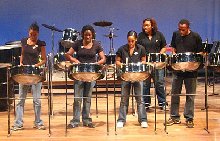Conventional Steelbands
(Steel Drum Bands)
Up until the 1950’s, steel pans (steel drums) were played while hung around the neck of the performer or while being carried in one hand of the performer.
In 1954, legendary pan innovator and arranger Anthony Williams mounted pans on stands to facilitate a performance at the Trinidad Music Festival.
Hanging the pans on stands allowed pannists to play more elaborate musical arrangements. It also meant one person could now play more than one drum at the same time and new types of pans with multiple drums and wider ranges were developed.
These stationary bands became known as Conventional Steelbands.

The Instruments of the Conventional Band
A typical conventional steelband (depending on the size), will contain some or all of the following instruments:
- Frontline pans -tenor pans, double tenor pans, double seconds pans
- Mid-range pans -quadraphonic pans, cello pans, guitar pans
- Background pans -tenor bass pans, six bass pans, seven or nine bass pans
- Engine room
Advantages
- All the pans can play and modulate in every key
- Mid-range and background pans can play extended solos
Disadvantages
- Multiple pan sets and stands make these types of bands bulky and more expensive to transport than single pan bands
- If it is to be mobile, the stands have to be secured to the back of a truck or wheels attached to the stands
- Larger storage and rehearsal areas are needed than with single pan bands
Home
>>
Types of Steelbands
>> Conventional Steelbands